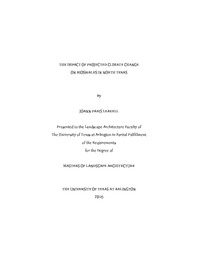
ATTENTION: The works hosted here are being migrated to a new repository that will consolidate resources, improve discoverability, and better show UTA's research impact on the global community. We will update authors as the migration progresses. Please see MavMatrix for more information.
Show simple item record
| dc.contributor.advisor | Hopman, David | |
| dc.creator | Leavell, Joann Paris | |
| dc.date.accessioned | 2017-02-14T16:17:59Z | |
| dc.date.available | 2017-02-14T16:17:59Z | |
| dc.date.created | 2016-12 | |
| dc.date.issued | 2016-12-07 | |
| dc.date.submitted | December 2016 | |
| dc.identifier.uri | http://hdl.handle.net/10106/26412 | |
| dc.description.abstract | This research addresses how bioswales are affected by the projections for climate change in the North Texas region. Bioswales are a type of green infrastructure that conveys stormwater before directing it to a storm sewer system or other flood control structure (McLaughlin, 2016). They minimize the volume of stormwater runoff from the ground level and allow for the infiltration and remediation of pollutants while reducing the amount of water that is directed towards storm sewers. The research seeks to provide an understanding of how the efficacy of bioswales is related to the projected climatic conditions in North Texas and their resiliency related to these shifts. The affects of climate change are manifesting themselves in diverse ways across the globe in the form of droughts, rainfall, and more intense storm events (Adger, et al., 2011). This research studies the resiliency of bioswales and their ability to absorb the disturbance of projected climatic conditions while retaining their functionality within the built environment of North Texas. The use of bioswales by landscape architects is slowly becoming a component of normative practice. However, it is unclear what degree of knowledge the average landscape architect and related professionals in North Texas currently possess on the topic. In part, this study seeks to determine whether the use of bioswales is a common practice or primarily relegated to common knowledge that is not implemented. A greater understanding of the relationship between climate change and bioswales will facilitate implementation by better preparing landscape architects and related professionals to design for the impending effects climate change has on bioswales. This research makes use of qualitative methods of data collection and ethnographic interviews with professionals to gain an understanding of the topic. Data for the literature review was collected form scholarly journals, professional papers, and academic texts, as well as government web sources. Qualitative data collection assisted the researcher in identifying themes within the interviews that linked to comprehensive findings from the data collection. The Diffusion of Innovation theory was instrumental in this research to assist the researcher in understanding how information is spread throughout the field of landscape architecture and related professions. The research focuses on understanding the Diffusion of Innovation, or spread of ideas, related to bioswales across the fields of landscape architecture and related professions in North Texas. The data collected indicates that the current technologies and methods of bioswale planning and construction may not be equipped to withstand the shifting climate in North Texas. More information needs to be available in the fields of stormwater management and green infrastructure to help educate professionals and the public on the benefits of these systems throughout the North Texas region and to improve their efficacy. | |
| dc.format.mimetype | application/pdf | |
| dc.language.iso | en_US | |
| dc.subject | Bioswales | |
| dc.subject | Climate change | |
| dc.title | The Impact of Projected Climate Change on Bioswales in North Texas | |
| dc.type | Thesis | |
| dc.degree.department | Landscape Architecture | |
| dc.degree.name | Master of Landscape Architecture | |
| dc.date.updated | 2017-02-14T16:17:59Z | |
| thesis.degree.department | Landscape Architecture | |
| thesis.degree.grantor | The University of Texas at Arlington | |
| thesis.degree.level | Masters | |
| thesis.degree.name | Master of Landscape Architecture | |
| dc.type.material | text | |
Files in this item
- Name:
- LEAVELL-THESIS-2016.pdf
- Size:
- 4.617Mb
- Format:
- PDF
This item appears in the following Collection(s)
Show simple item record


